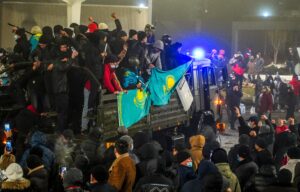January 2022, Volume 33, Issue 1
Kyrgyzstan’s Poison Parliament
Kyrgyzstan’s parliamentary-style constitution was a democratic bright spot in Central Asia. But the legislature quickly devolved into a corrupt bazaar, dimming its democratic prospects.
January 2022, Volume 33, Issue 1
Kyrgyzstan’s parliamentary-style constitution was a democratic bright spot in Central Asia. But the legislature quickly devolved into a corrupt bazaar, dimming its democratic prospects.
July 2017, Volume 28, Issue 3
A review of Dictators Without Borders: Power and Money in Central Asia by Alexander Cooley and John Heathershaw.
January 2014, Volume 25, Issue 1
January 2014 marks the tenth anniversary of Afghanistan’s constitution. In what areas has it succeeded or failed? Judging by its achievements with respect to four midrange goals, the document has a record that is decidedly mixed.
July 2011, Volume 22, Issue 3
Having thrown out a corrupt, authoritarian president for the second time, this Central Asian republic has gained a new chance at securing a real democratic transition.

July 2010, Volume 21, Issue 3
After almost ten years of complex and costly efforts to build democracy in these two countries, where do things stand? What lay behind the critical choices that shaped events in these places, and what are their current prospects for success?
April 2006, Volume 17, Issue 2
The March 2005 “Tulip Revolution” that toppled President Askar Akeyev is often grouped with the “color revolutions” in Georgia and Ukraine, but in many ways the Kyrgyz case was unique.
October 2002, Volume 13, Issue 4
What do Muslims think about democracy? Although reliable evidence is hard to come by, survey data from Central Asia open a window on this matter of vital concern in the Muslim world and beyond.
July 2002, Volume 13, Issue 3
This region’s five republics have just lived through a remarkable first decade of independence that raises questions about “preconditions”-based theories of democratization.
October 2001, Volume 12, Issue 4
The Editors’ introduction to “Ten Years After the Soviet Breakup.”
October 2001, Volume 12, Issue 4
The 15 states of the former Soviet fall into three broad categories, largely defined by fault lines of history and culture.
October 2001, Volume 12, Issue 4
To grasp what is happening in the former USSR, we must examine the types of nationalism that flourish there.
October 2001, Volume 12, Issue 4
Except for the Baltic states, the countries of the former Soviet Union may be less democratic today than in the last years of the USSR.
October 2001, Volume 12, Issue 4
The failures of post-Soviet reform notwithstanding, serious strides have been made toward economic and political transformation.
October 2001, Volume 12, Issue 4
In the southern reaches of what was once the USSR, democracy seems far off. Can that change?
October 2001, Volume 12, Issue 4
Despite huge changes, the events of the last ten years raise doubts about the notion of “democratic transition” itself.

The Chinese Communist Party is attempting to rename the Tibetan people’s homeland, part of a wider effort to eradicate Tibet’s cultural identity. For Tibet, it’s more than just a name.
In 2022, we began publishing shorter, exclusively online pieces. No topic mattered more to you than Russia’s disastrous war in Ukraine. We also published essays from the sharpest minds on protests in China and Iran, instability in Pakistan, and more.

Thousands took to the streets to protest. While the regime promises to listen, its actions make clear: Dissent will not be tolerated.